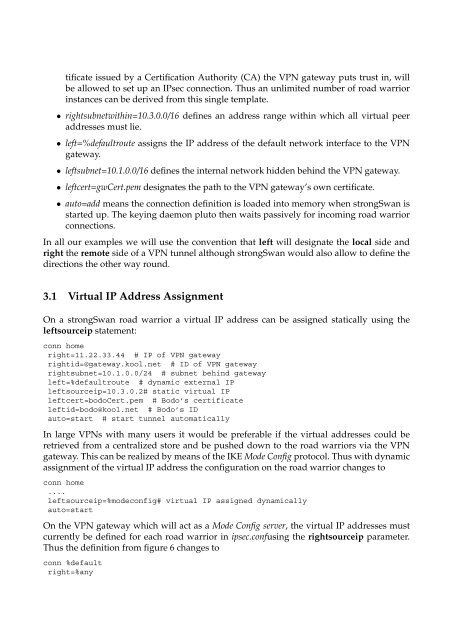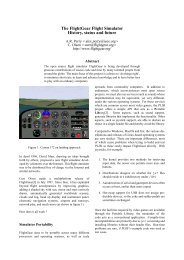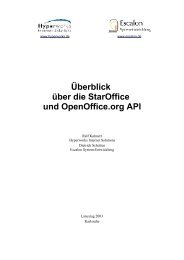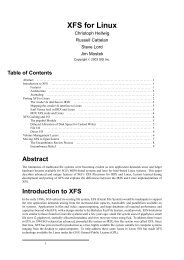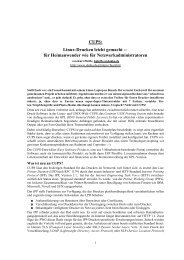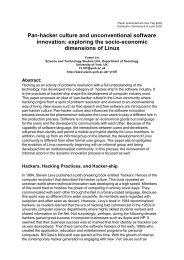Advanced Features of Linux strongSwan - the OpenSource VPN ...
Advanced Features of Linux strongSwan - the OpenSource VPN ...
Advanced Features of Linux strongSwan - the OpenSource VPN ...
You also want an ePaper? Increase the reach of your titles
YUMPU automatically turns print PDFs into web optimized ePapers that Google loves.
tificate issued by a Certification Authority (CA) <strong>the</strong> <strong>VPN</strong> gateway puts trust in, will<br />
be allowed to set up an IPsec connection. Thus an unlimited number <strong>of</strong> road warrior<br />
instances can be derived from this single template.<br />
• rightsubnetwithin=10.3.0.0/16 defines an address range within which all virtual peer<br />
addresses must lie.<br />
• left=%defaultroute assigns <strong>the</strong> IP address <strong>of</strong> <strong>the</strong> default network interface to <strong>the</strong> <strong>VPN</strong><br />
gateway.<br />
• leftsubnet=10.1.0.0/16 defines <strong>the</strong> internal network hidden behind <strong>the</strong> <strong>VPN</strong> gateway.<br />
• leftcert=gwCert.pem designates <strong>the</strong> path to <strong>the</strong> <strong>VPN</strong> gateway’s own certificate.<br />
• auto=add means <strong>the</strong> connection definition is loaded into memory when <strong>strongSwan</strong> is<br />
started up. The keying daemon pluto <strong>the</strong>n waits passively for incoming road warrior<br />
connections.<br />
In all our examples we will use <strong>the</strong> convention that left will designate <strong>the</strong> local side and<br />
right <strong>the</strong> remote side <strong>of</strong> a <strong>VPN</strong> tunnel although <strong>strongSwan</strong> would also allow to define <strong>the</strong><br />
directions <strong>the</strong> o<strong>the</strong>r way round.<br />
3.1 Virtual IP Address Assignment<br />
On a <strong>strongSwan</strong> road warrior a virtual IP address can be assigned statically using <strong>the</strong><br />
leftsourceip statement:<br />
conn home<br />
right=11.22.33.44 # IP <strong>of</strong> <strong>VPN</strong> gateway<br />
rightid=@gateway.kool.net # ID <strong>of</strong> <strong>VPN</strong> gateway<br />
rightsubnet=10.1.0.0/24 # subnet behind gateway<br />
left=%defaultroute # dynamic external IP<br />
leftsourceip=10.3.0.2# static virtual IP<br />
leftcert=bodoCert.pem # Bodo’s certificate<br />
leftid=bodo@kool.net # Bodo’s ID<br />
auto=start # start tunnel automatically<br />
In large <strong>VPN</strong>s with many users it would be preferable if <strong>the</strong> virtual addresses could be<br />
retrieved from a centralized store and be pushed down to <strong>the</strong> road warriors via <strong>the</strong> <strong>VPN</strong><br />
gateway. This can be realized by means <strong>of</strong> <strong>the</strong> IKE Mode Config protocol. Thus with dynamic<br />
assignment <strong>of</strong> <strong>the</strong> virtual IP address <strong>the</strong> configuration on <strong>the</strong> road warrior changes to<br />
conn home<br />
....<br />
leftsourceip=%modeconfig# virtual IP assigned dynamically<br />
auto=start<br />
On <strong>the</strong> <strong>VPN</strong> gateway which will act as a Mode Config server, <strong>the</strong> virtual IP addresses must<br />
currently be defined for each road warrior in ipsec.confusing <strong>the</strong> rightsourceip parameter.<br />
Thus <strong>the</strong> definition from figure 6 changes to<br />
conn %default<br />
right=%any


